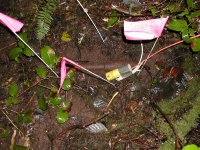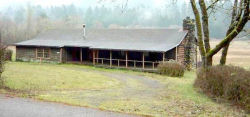
A 2.36" Rocket which was determined to be "Unexploded Ordnance" (Fired armed and did not function) It was found near demolition area 1 during monitoring well installation. (phote: epa)
Camp Bonneville (nearly 4000-acres) is an Army installation that was closed in 1995. It is located in Southeast Clark County about 12 miles east of Vancouver, WA. Established in 1909, the Camp has been used to train many generations of military personnel with field artillery. At one point, Royce Pollard, now Mayor of the City of Vancouver, was the commander of this facility. The Camp was decommissioned by the Army, and the property is slated for transfer to the Clark County Parks Department sometime within the next ten years. Plans have been mentioned for the County to build a public amphitheater and to open the area to hiking and other public uses.
However, during the Camp’s life as a training facility, a variety of weaponry was used and a vast amount of toxic waste was left behind. Still lingering in the wooded areas, meadows and wetlands of the six square-mile camp are rocket parts, mortars, bullets, grenades, traces of chemical weaponry and missiles. Some of these munitions are termed “Unexploded Ordnance,” or UXO, weapons that were launched or fired but did not detonate.
UXO and other military debris are a source of the carcinogenic substance known as ammonium perchlorate, a combustible component used in munitions and rocket fuel. A plume of ammonium perchlorate has poisoned the groundwater at Camp Bonneville in a place that abuts Lacamas Creek. This toxic substance leaked into the groundwater from landfill pits that were used to bury discarded munitions. Lacamas Creek is a known habitat for endangered salmon.
Residents in the surrounding area rely upon well water, and the moving underground plume could potentially render the drinking water unsafe for consumption in some places. Recent water quality test results (October 2004) indicate a sentry well, located downstream from the plume and on the opposite side of the camp, to have tested positive for ammonium perchlorate. This could mean that the plume has moved quite far underground. The sentry well in question abuts a private residence. The army conducts quarterly water sampling tests, and results from the January 2005 sampling may show if ammonium perchlorate is still present at the new sentry well location. The Army suspects the identification of ammonium perchlorate at the sentry to have been a “false positive,” but only repeated quarterly samplings will tell.
By digging down nearly 20 feet and removing the soil and the buried weapons debris, the Army is attempting to counteract the source of waterborne contamination at the landfill location. The contaminated soil was removed to a landfill in Oregon designed to contain such contaminated waste, and fresh soil was trucked in to backfill the landfill at Camp Bonneville. The interstate transfer of the contaminated soil was not condoned by citizen volunteers witnessing the project.
Thus far, water sampling tests do not indicate a lessening of the ammonium perchlorate concentrations of the plume at Camp Bonneville — the process may take many years. Furthermore, the cleanup at landfill #4 represents only about four acres of cleanup among the nearly 4000 acres of the camp. These four acres are the only clean-up that has occurred in the past 8 years. The Army is responsible for all cleanup efforts at the Camp (in perpetuity), even after the transfer of the land to the County takes place. However, the cleanup process has been painfully slow. It could take years for this problem to be thoroughly rectified.
The presence of UXO at Camp Bonneville indicates a vast potential for human harm, as these abandoned munitions may still be active and able to explode upon contact. There are decommissioned military installations like Camp Bonneville all over the country. The danger lies in the fact that, although abandoned, the grounds are not secured and there is easy public access. To date, there have been nearly 150 incidents nation-wide where the public has gained access to places like Camp Bonneville, all resulting in serious injuries or death when the UXO was handled by those who were unaware of the dangers involved. Three boys in San Diego were recently killed because they handled UXO. People have even collected UXO only to have it explode in their homes.
During the cleanup process at Camp Bonneville, the Army has collected various forms of UXO taken from landfill #4, and has detonated this UXO on site using explosive in pits. There are various firing ranges that have yet to be cleared of UXO at the Camp.
Video footage from the 1950′s shows Howitzer missile launchers employed on what was called the parade grounds of Camp Bonneville. The parade grounds were an open field at the base of the Camp, overlooking the “saddle,” a forested mountain area directly to the northeast. Some of the missiles fired at Camp Bonneville have a range beyond six miles, and debris from test firings may exist beyond the confines of the camp and well into newly developed gated communities such as Summer Hills and Autumn Hills that were built at the Camp’s borders since the early 1990′s.
Historic documentation shows that Howitzer missiles, like those launched at Camp Bonneville, could have contained depleted uranium. The missiles were launched from the parade grounds into the saddle area where tanks were placed as targets. The purpose of such tests was to determine if the missiles could pierce armor plating commonly used in tanks. New LIDAR technology may be used sometime in the future to identify impact craters and other evidence of Army munitions at Camp Bonneville. LIDAR is laser-light topographic photography that is generated by overflights of specially fitted aircraft. The City of Portland is considering the use of LIDAR to map the entire Portland Metro area for planning purposes.
According to recent testimony received by the Restoration Advisory Board (RAB) of the Camp, a group that is monitoring the Army’s cleanup efforts, residents immediately adjacent to Camp Bonneville are not aware that the UXO presents a clear and present danger to the community. Furthermore, a barbed wire fence that was thought to secure the northern perimeter of the camp (separating the camp from adjacent residential areas) was either purposefully removed or had fallen into serious disrepair. Some small, unobtrusive warning signs were posted on or near the perimeter fence in the late 1990′s, but these signs are not only hard to read, but many may be missing altogether. Universal warning signs were not used.
Neighbors report that they have freely allowed their children to venture into the camp, explaining that the camp was abandoned by the army and must, therefore, be safe for public access. Residents have also stated that family dogs were allowed to roam freely in the camp and have failed to return home. There have been various reports of explosions, but since there is still an active FBI shooting range on the camp grounds, residents in the area were not overly concerned — they were under the false assumption that all munitions had previously been removed by the Army.
Army BRAC Coordinator, Eric Waehling, repeatedly claimed to have toured the perimeter of the facility, noting that the camp was supposedly secured from the public. However, a resident of Summer Hills invited one of the RAB members, a citizen volunteer, to access Camp Bonneville’s northern perimeter through private property. A video taken on February 8, 2005, clearly shows the fence is missing. The three tiers of barbed wire have been removed and fenceposts have been bent or pulled out of place. Some fenceposts stand void of wire. It is not known how the fence came to be in such a state, though it is known to have been in disrepair for many years, contrary to Eric Waehling’s reports. The video evidence showing the decline of the fence was viewed at the RAB meeting on February 9, 2005. The Summer Hills resident who initiated the investigation of the fence stated that she has been completely unaware of any danger, even though she has lived in the neighborhood since the 1990′s.
The February 8 video even shows fresh footprints in snow where someone had ventured into Camp Bonneville property via a commonly used trail. There are trailways throughout the area that lead directly into the firing range where UXO is still known to exist. Some debris in the area may have lodged in tree trunks. Residents claim that they were completely unaware of the UXO, and that they were not warned of the public safety issue prior to the purchase of property in the area.
Attendees to the RAB meeting voiced their concerns for public safety in light of the fact that the Camp fence was clearly missing and that the residents of the area were unaware of the dangers present. Marc Boldt, newly-elected Clark County Commissioner, was in attendance at the February 9 RAB meeting, and he committed to immediately notifying the residents of this safety issue. RAB attendees stated that a permanent fence needs to be installed immediately, especially since the UXO may never be totally removed from the site. Eric Waehling complained that he does not have the funding to install a new fence, though he has made a request to the Army to secure the funds. However, budgetary constraints may prevent an appropriate fence from being installed. Camp Bonneville employs only one groundskeeper.
The RNA has attended various RAB meetings, where information about the cleanup of Camp Bonneville has been discussed in court-reported sessions. The transcripts of these meetings are available to the public at the Public Library, Westfield Shopping Town location. Oversight of the cleanup efforts is conducted by the Washington State Department of Ecology, and the US Department of Defense.
On its website, Clark County describes Camp Bonneville as property that “has captured the imagination of hikers, equestrians, parks planners, wildlife enthusiasts, campers, Native American groups, and many others.” Given the severity of the dangers present, one wonders if it is prudent for Clark County to plan to transform Camp Bonneville into a public park.











![Washington State Water Quality Assessment [303(d)] Washington State Department of Ecology](http://www.rosemerena.org/home/wp-content/uploads/2009/03/ecy_logo.gif)

